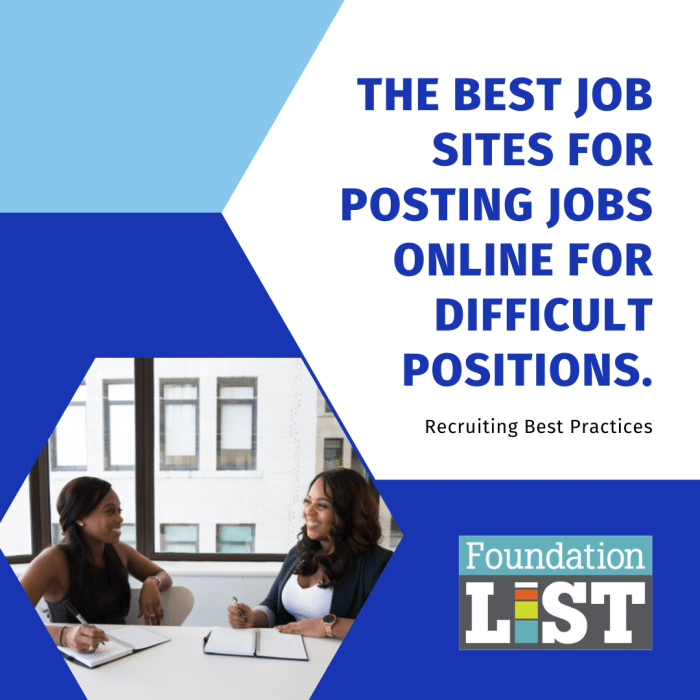This post explores best practices for posting jobs on recruiting websites, discusses the best job sites to post jobs online, and gives step-by-step instruction on what you should do if you are recruiting for difficult, competitive, or hard to fill roles. Casting a wide net is the key when trying to recruit and identify talent for difficult position or competitive markets. To bring the best-qualified candidates to your open jobs, you must follow core recruitment philosophies.
Rule #1 Your market matters.
Every industry is unique and the candidates within them act, and search for jobs differently. You must first understand where your target candidate looks for jobs, and how they expect to find new career opportunities. This insight is critical to success. To do so, you must have interacted with candidates in this specialty or conduct research to understand the culture of the sector and location for which you are recruiting. If you do not understand this core and key concept, you will fail to recruit the best talent. For instance, some markets with zero unemployment may require you to post on a higher number of job boards, and some industries may not follow online postings at all. Knowing how your target audience interacts with online and career information is vital to your success. If you do not know this yet, do not worry – this blog post will discuss this and the steps you need to consider.
Rule #2: Titles matter.
Do not make the most common mistake: advertising a job title that is offering under market compensation. Under market, when used to describe job titles, is a title that is advertising a salary below the median 50% salary level for your region and job sector. If you want to fill the role with a well-qualified applicant, be sure your offered salary range is appropriate for the title you have listed. If your salary is lower that the median, adding a bigger title will not help you fill the role. In fact, inflating the title will make it less likely that you will attract applicants. Make sure your title and compensation are a match or above the median salary for your local area. If you are not sure, perform a google search for the title of the role you are looking to fill with the word salary and the city. The number one reason jobs go unfilled is the title is too high for the offered salary. Instead, choose a title that is a full match for your compensation level. This sets the right expectations with the potential candidates and provides room for growth. Downgrading a title, and in many respects keeping most all of the responsibilities can be a useful tactic if your organization can not afford to increase the range and your positions are staying unfilled. Why this works is simple: applicants open to that title, will also be open to the salary range that is a match for that title. The higher the title the greater the expectation of higher compensation. That being said, we would always suggest first simply increasing your original compensation range to above the median and utilizing your original target title. We believe that employers should always try to pay above the median salary range. Fairly compensated employees are happier, more productive and have longer tenure with their place of employment.
Rule #3: Understand candidate behavior.
Thinking like the candidate you want to hire will help you to create an effective recruitment plan for your open roles. Once you understand how your target candidate group spends time on social media, what sites they use, and how you can reach them – you will have success in hiring for your difficult to fill roles.
Following are some examples of candidate behaviors per industry.
Nonprofit: This is a proactive group who actively looks online for new job opportunities. You can reach them via phone and email, and are active on social media. They generally follow nonprofit job postings if seeking new roles. They are reachable via networking on LinkedIn or direct contact. Job posting approaches that concentrate on industry-based boards and incorporate social media are ideal.
Professional/Service: This is group that is active on LinkedIn, meet up groups, and is highly recruited. The candidates most active in their search are traditionally in employment transition, changing careers, or seeking advancement in pay or responsibilities. They are very active on social media and consider the reviews and digital presence of a company prior to applying.
Legal: This group is less active on LinkedIn and social networking as a whole. They are very responsive to networking reach outs. If they are seeking work, they tend to use larges sites such as indeed, zip recruiter, LinkedIn, or social media.
Medical & Health: This is a passive group that does not actively look online for new job opportunities and can be difficult to reach unless via phone. This group is active on social media but is accustomed to position opportunities coming to them. If they are seeking work, they tend to use larges sites such as indeed, zip recruiter, LinkedIn or social media.
Light Industrial: This group tends to rely on staffing and recruiting companies to be an intermediary to new roles more than direct applications. This group relies on personal referrals and personal connections to hire and find experienced professionals. Executive level roles are the best match for larges sites such as indeed, zip recruiter, LinkedIn.
Finance & Accounting: This group is less active on LinkedIn and social networking as a whole. They are very responsive to networking reach outs. If they are seeking work, they tend to use larges sites such as indeed, zip recruiter, LinkedIn, or social media.
Rule #4: Write compelling job descriptions and job advertisements.
Nine times out of ten, employers do not put enough time in creating an attractive and positive job announcement that will attract their target talent. For competitive roles, your posting must be exciting and attractive. Write your posting with strategy to pull the available candidates for competitive positions. Make sure your opportunity announcement starts with excitement and positivity! Most job seekers read the very first paragraph to deciding if they want to learn more about the job. Also, make sure the work sounds like it will be fun, challenging and rewarding. No matter what the responsibilities are, make sure to write about the work in the most positive light! Keep in mind that the description is your opportunity to showcase the most important aspects of the role and to get the candidates excited about working for you. Lastly make sure to include all the perks, benefits, and detailed information about how great your organizations is, how talented the team is, and why someone would want to join you! For more detailed instructions on how to write compelling and effective job descriptions we would recommend also reading this to help you.
Rule 5: Concentrate your efforts.
Take a direct approach: post jobs on multiple sites at the same time to get the word out successfully. What does that mean? Post on multiple sites on the same day or consider using job aggregators to get your position on multiple sites. In addition to industry specific boards make sure to post your jobs on the main large sites as well. You will need to post your well-crafted and attractive job announcement, conduct direct outreach, and network to find the staff you need. If you do not have time, consider hiring a great search firm.
Rule 6. Only use the best modern online job boards.
We would highly suggest posting your job at the same time on social media, industry boards, LinkedIn, Indeed, Zip Recruiter, Glassdoor and other sites to get your open position the highest amount of exposure. There are some great job aggregation posting sites that can make this much easier to get the word out on some of the leading job boards. They also include social media posts about your openings. But do not forget to go over the basics above. Being strategic and making sure you are recruiting the right title and have an attractive job description should not be overlooked. Read more information on the top sites to post nonprofit jobs to get great candidates for your difficult positions.
Rule 7. Do not forget the basics.
It does not matter where you post your open position online if:
- Your job announcement is not well written and attractive to candidates;
- Your title is too high for the salary you wish to offer. Instead revamp your strategy to meet your budget;
- Your offered salary is lower than the median salary in your region and you are in a limited of competitive market;
- You do not post on multiple sites at the same time;
- You do not have a candidate sourcing strategy for markets where candidates are not active on job boards. See above for examples.
If any of the above are true for your organization. Do not panic. It is time to think creatively, and you will need to put the work in to network and directly source talent for your openings. The more attractive your job postings are, the less you will ultimately need to do direct recruiting to fill your open staff requisitions. First, review the strategy and make your posting be the most attractive as possible for your market. If you are not sure how you stack up, Google your job title and take a look at other employers like you. But do not compare their salary to yours if it is lower then what you will be offering. Simply because a job is posted with a salary, does not mean it is a competitive amount, nor does it mean your competition will ever fill their open position. Instead, use online salary surveys and make sure you offer a range above the median, so it is fair and attractive to candidates. Lastly, do not forget the power of career growth. If there is room for growth or promotion make sure to highlight that aspect early and often in your job announcement. The best of the best are always targeting long-term career growth. Wouldn’t you?


